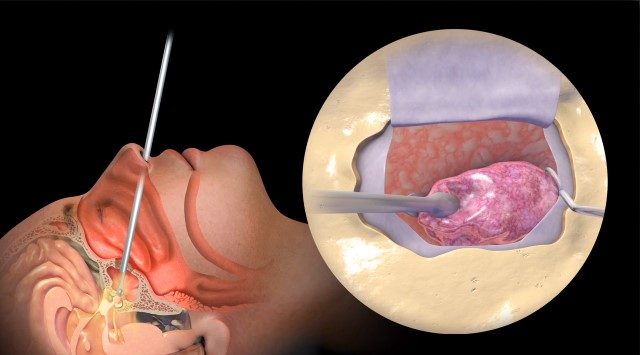
Transsphenoidal Surgery
What is transsphenoidal surgery?
Transsphenoidal surgery is the most common procedure for removing a tumor of the pituitary gland. Rather than opening up the skull in a traditional craniotomy, the neurosurgeon reaches the tumor through the nasal passages and the sphenoid sinus. This less-invasive approach allows the neurosurgeon to avoid important brain structures by accessing the pituitary gland from underneath the brain. Transsphenoidal surgery leaves no visible scar, minimizes the risk of complications, and enables faster recovery.

The neurosurgeon makes a small incision in the back wall of the nasal passages to enter the sphenoid sinus and then open up the sella turcica, the bony cavity that contains the pituitary gland. A thin tube with a light and camera at the tip, called an endoscope, allows the surgeon to see through the small incision and view the magnified operative field on a television screen.




What is transsphenoidal surgery used for?
Transsphenoidal surgery is used to treat tumors that arise from the pituitary gland. The pituitary gland is a pea-sized organ located at the base of the brain and above the inside of the nose. It regulates most of the body’s hormones.
Pituitary tumors are almost always benign (noncancerous) growths called adenomas. Although pituitary adenomas do not spread to other parts of the body like malignant (cancerous) tumors, they can still cause many problems if left untreated. Some pituitary tumors are ‘functioning” tumors, meaning they secrete hormones. The overproduction of certain hormones can cause diseases like acromegaly and Cushing’s disease. Tumors that do not secrete hormones, called “nonfunctioning” tumors, can increase in size and press on other parts of the brain, causing symptoms like headaches and vision loss.
Am I a good candidate for transsphenoidal surgery?
You may be a good candidate for transsphenoidal surgery if you have a pituitary tumor. Surgery is usually the first line of treatment for both functioning and nonfunctioning pituitary tumors. However, prolactin-secreting tumors are initially treated with medical therapy as they often respond well to medications that block the production of prolactin. If you have a small nonfunctioning tumor that is not causing symptoms, your doctor may monitor the tumor for growth with MRI scans before proceeding with surgery. Rarely, a craniotomy is required to remove a pituitary tumor.
How should I select a surgeon to perform transsphenoidal surgery?
The most important factor for selecting a surgeon is the experience of the surgeon. Patients whose surgeons perform more than 100 pituitary surgeries per year have better outcomes than patients whose surgeons perform only a few pituitary operations per year.
Patients should also seek treatment at a hospital where there is a Pituitary Center comprised of a dedicated team of pituitary specialists. Since pituitary tumors can affect the whole body, you will need a team of specialist caring for you.
Some questions to ask when selecting a pituitary surgeon:
- How many pituitary surgeries do you perform a year?
- Ideally, they should perform at least 100 surgeries per year.
- Do you work as part of a pituitary team, or pituitary center?
- How long do your patients typically stay in the hospital after surgery?
- Patients who have surgery by expert surgeons usually are in the hospital for 1 to 2 nights for most types of pituitary conditions.



